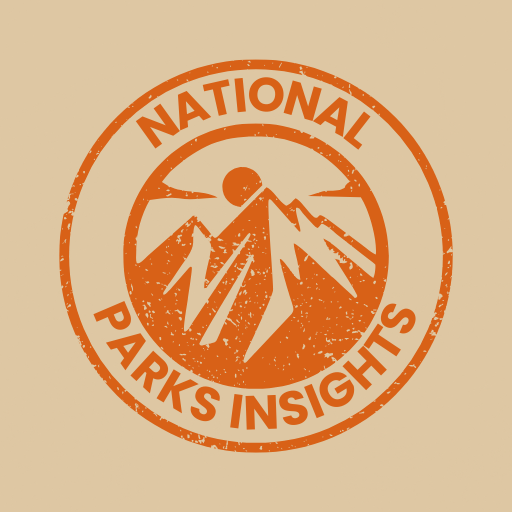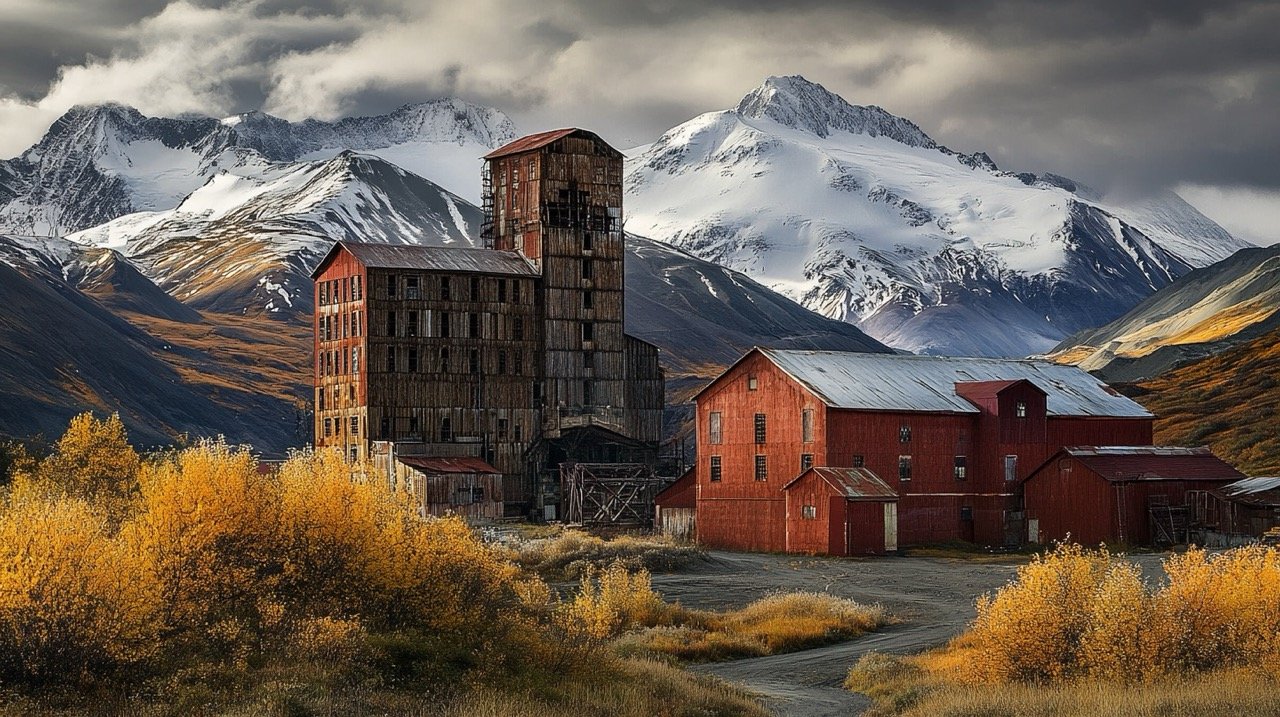Exploring Kennecott Mines
A Peek into the Past
Step into the Kennecott Mines in Wrangell St. Elias National Park, and you’re diving into a rich slice of history. These mines, buzzing from 1911 to 1938, were famous for churning out some of the purest copper around. By the time they shut down in 1938, they had pulled out 591,535 short tons of copper from 4,525,909 tons of ore, worth a whopping $200,000,000 in 1938 dollars.
| Year | Copper Extracted (Short Tons) | Ore Processed (Tons) | Value (1938 Dollars) |
|---|---|---|---|
| 1911-1938 | 591,535 | 4,525,909 | $200,000,000 |
Stephen Birch kicked off the Kennecott Mines Company in 1906, and it quickly became a hive of activity. By 1920, about 500 folks called the town home, all working hard to keep the mining gears turning. The Kennecott Mines National Historic Landmark, recognized in 1986, keeps this amazing history alive for you to explore today.
The Heart of Kennecott
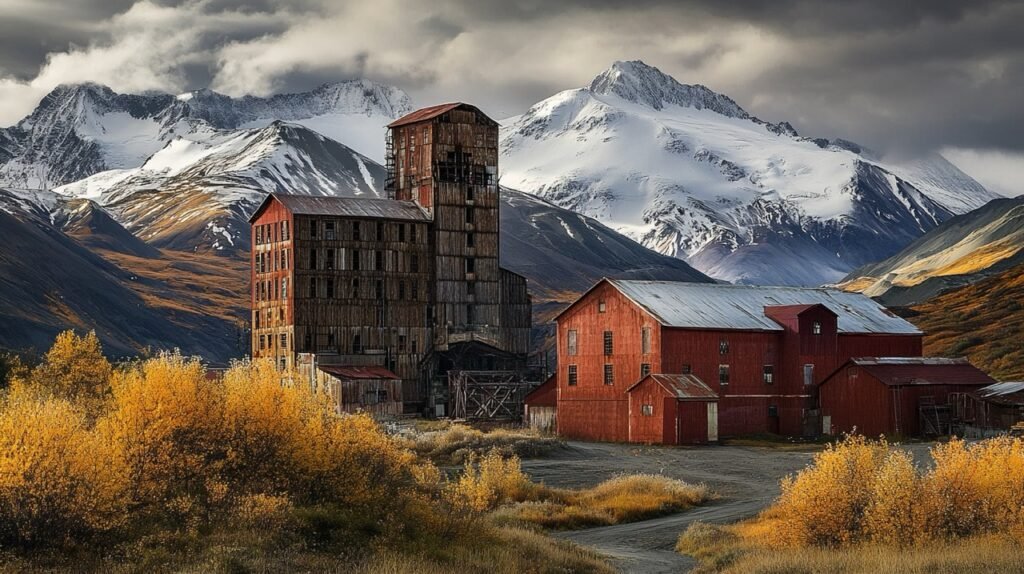
Kennecott was more than just a mining spot; it was a lively community. As a company town, it had neatly arranged frame buildings where company officials and their families lived. Life in Kennecott was bustling with amenities like a school, library, hospital, and places for movies and dances, creating a tight-knit community vibe.
| Facility | Description |
|---|---|
| School | Education for the town’s kids |
| Library | A collection of books for learning and fun |
| Hospital | Health care for the residents |
| Recreational Facilities | Movies and dances for entertainment and socializing |
Strolling through Kennecott today, you can still feel the echoes of its past. The buildings, though aged, stand as proof of the town’s hardworking spirit. These preserved structures let you imagine life during Kennecott’s heyday. For more details about the area, check out our page on Wrangell St. Elias Alaska.
The Kennecott Mines give you a unique look into the history of the largest national park in the United States. As you wander around, you’ll uncover the captivating story of how this remote spot became a key site for copper mining and the lively community that flourished here.
Click here to see Beautiful Hotel Options at Wrangell St. Elias
Mining Operations
Exploring the Kennecott mines is like stepping into a time machine. You get to see how mining was done back in the day and uncover the secrets of the Jumbo Mine.
Extraction and Production
The Kennecott mines were famous for their smooth and efficient operations. From 1909 to 1938, with a brief pause in 1932, these mines churned out over 4.6 million tons of ore, which held a whopping 1.183 billion pounds of copper. They used methods like crushing, concentrating, leaching, and flotation to get the copper out. The Kennecott team managed to extract 98% of the copper, raking in over $200 million in revenue and more than $100 million in profit before the ore vein dried up in 1938.
At its peak, around 300 folks worked in the mill town, and another 200-300 toiled in the mines. The mill itself was a 14-story engineering marvel, designed to separate copper from limestone.
| Year | Copper Produced (lbs) | Profit ($) |
|---|---|---|
| 1911-1938 | 1.183 billion | $100 million |
The Jumbo Mine

The Jumbo Mine was a big deal in the Kennecott area. Sitting 4,000 feet above the town, just getting there was an adventure. Miners had to take a 45-minute tram ride, signing a waiver before they left the ground. Along with the Bonanza and Mother Lode mines, the Jumbo Mine was a major player in Kennecott’s copper production.
This mine was crucial to the whole operation, and it helped keep productivity high. The tram ride wasn’t just about getting to work; it also offered stunning views of the surrounding area, making it a memorable part of the miners’ day.
By learning about the extraction and production processes and the importance of the Jumbo Mine, you can really appreciate the historical significance of the Kennecott mines. Want to know more about Wrangell St. Elias National Park? Check out our detailed guide on Wrangell St. Elias National Park and explore other cool spots like Mount St. Elias. For more info on the largest national park in the U.S., visit largest national park in the United States.
Transportation and Infrastructure
When you visit the historic Kennecott Mines in Wrangell St. Elias, you’ll be blown away by the sheer ingenuity that made the mining operations tick. The Copper River Railroad, along with the aerial trams and tunnels, were the lifelines that kept the copper flowing and the mining community thriving.
The Copper River Railroad
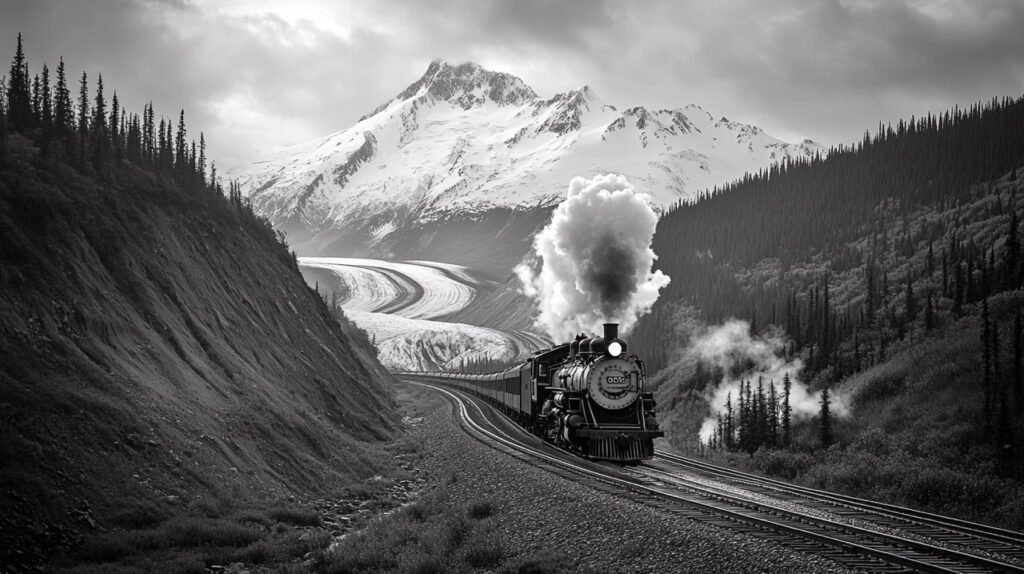
The Copper River Railroad, built by the Kennecott Mines Company, is nothing short of an engineering marvel. Between 1905 and 1911, this 200-mile railroad was constructed to connect the mines to the nearest seaports. Imagine the challenges: transporting copper across gravel-covered glaciers and navigating steep mountain passes.
By 1911, the Copper River Northwest Railroad was up and running, stretching from Cordova to Kennecott along the Copper River. This railroad became the main artery for moving ore and people to and from Kennecott. Its construction marked a huge milestone, making the efficient movement of copper ore possible and ensuring the mining operations’ success.
| Year | Milestone |
|---|---|
| 1905 | Construction of the Copper River Railroad began |
| 1911 | Completion of the Copper River Northwest Railroad |
Want to know more about the area? Check out Wrangell St. Elias Alaska.
Aerial Trams and Tunnels
But the railroad was just part of the story. The Kennecott Mines Company also built a sprawling network of aerial trams and tunnels to haul copper from the mountains to the concentration mill. Picture this: three miles of aerial trams bringing copper down from the mountain, a vital cog in the mining machine.
The mining operations also involved blasting five mines and linking them with 70 miles of tunnels. These tunnels allowed workers to reach the copper deposits and transport the ore to the surface efficiently. The aerial trams and tunnels were essential in keeping the mining town of Kennecott humming, home to 20 families and hundreds of workers.
This combo of aerial trams and tunnels didn’t just move copper ore; it kept the whole operation running like a well-oiled machine. The creativity and grit of the workers and engineers who built this infrastructure are a testament to the incredible history of the Kennecott Mines.
Curious about the region? Visit Mount St. Elias or learn about the largest national park in the United States.
Click here to see Beautiful Hotel Options at Wrangell St. Elias
The Concentration Mill
The concentration mill at the Kennecott Mines is a marvel of early 20th-century engineering and a crucial part of the mining operation. This 14-story giant turned raw ore into valuable copper, making it the heart of the operation.
Copper Separation Process
At the concentration mill, the main goal was to separate copper from the surrounding limestone. This process had several steps:
- Crushing: Big chunks of ore were smashed into smaller pieces.
- Separation: The crushed ore was then sorted to find the copper-rich bits.
- Concentrating: The sorted ore was refined to boost the copper content.
- Leaching and Flotation: These chemical processes pulled pure copper from the refined ore.
The mill was a beast, extracting 98% of the copper from the ore. This high success rate was crucial for keeping the Kennecott Mines profitable.
| Process Stage | Purpose | Efficiency |
|---|---|---|
| Crushing | Break down ore | High |
| Separation | Isolate copper-rich ore | High |
| Concentrating | Refine ore | High |
| Leaching and Flotation | Extract pure copper | 98% |
Why the Mill Mattered
The concentration mill was the lifeblood of the Kennecott Mines. Its smooth operation was key to the whole venture’s success. From 1911 to 1938, the Kennecott Mines churned out nearly $200 million worth of copper. At its peak, the mill town had about 300 workers, with another 200-300 in the mines.
The mill’s smart location and cutting-edge tech helped Kennecott thrive in Alaska’s tough conditions. The mill’s success boosted the local economy and played a big role in the industrial boom of the time.
Visiting the concentration mill today gives you a peek into the past and a sense of the grit and smarts of the folks who worked there. For more on the stunning natural surroundings, check out our articles on Wrangell St. Elias National Park and Largest National Park in the United States.
Life in Kennecott
Daily Life and Amenities
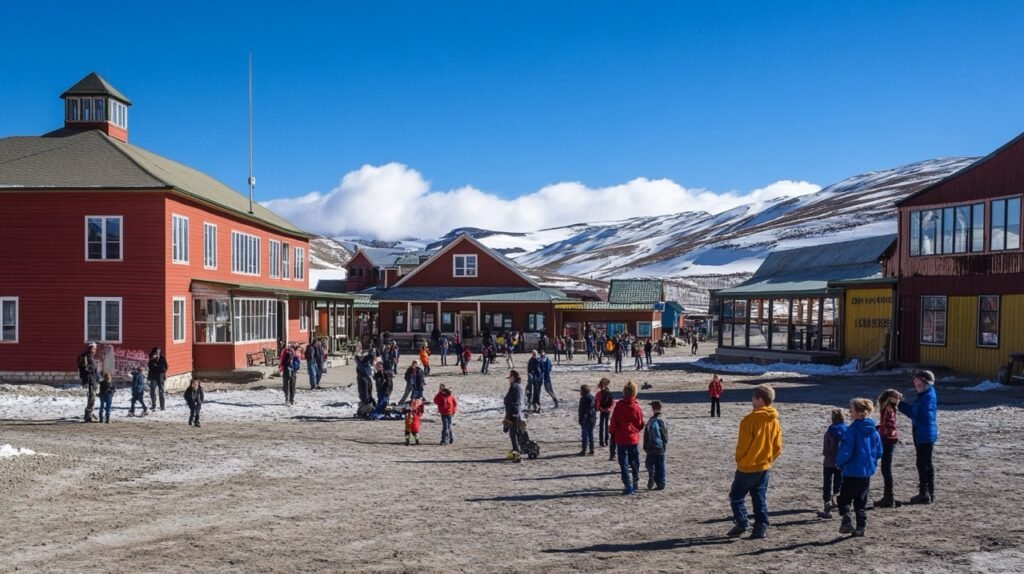
Living in Kennecott back in the day was quite the adventure. This company town, with its tidy frame houses, was home to company officials and their families. Even though it was in the middle of nowhere, Kennecott had plenty to keep folks comfy.
| Amenities | Description |
|---|---|
| Movies | Regular film screenings for entertainment |
| Dances | Social events for community bonding |
| School | An educational institution for children |
| Library | Access to books and educational materials |
| Hospital | Medical facilities for residents |
Kennecott was a well-oiled machine, running almost every day of the year, come rain, shine, or snowstorm. With temperatures often dipping below zero and snow piling up, the town kept chugging along. Around 300 people worked in the mill, and another 200-300 toiled in the mines. From 1911 to 1938, the Kennecott Mines churned out nearly $200 million worth of copper.
The Community Spirit
The sense of community in Kennecott was something special. Living and working in such a remote place meant everyone had to stick together. The town was home to about 20 families and hundreds of workers, creating a close-knit vibe. Social events like movie nights and dances were key to keeping spirits high and building friendships.
Everyone had a part to play in keeping the town running smoothly. The school, library, and hospital weren’t just there for services; they were also places where people gathered and bonded, making the community even stronger.
Diving into the history of Kennecott Mines and the daily lives of its residents gives us a peek into a unique past. For more on the history and importance of the Kennecott Mines, check out our articles on Wrangell St. Elias Alaska and Largest National Park in the United States.
Visiting Today
When you visit the Kennecott Mines in Wrangell-St. Elias National Park, you’re not just taking a trip; you’re stepping into a time machine. This place is a slice of history that shaped the region. Recognized in 1986, the Kennecott Mines National Historic Landmark is a goldmine of stories and activities.
Historic Landmarks
The Kennecott Mines are packed with historic spots that take you back to the early 1900s. The Wrangell-St. Elias National Park grabbed some key buildings in Kennecott and 2,800 acres of mining land in 1998. The National Park Service is working hard to keep the mill and other main buildings standing tall.
Key landmarks include:
- The Concentration Mill: This is where the magic happened—copper was separated from ore.
- The Power Plant: Kept the lights on and the machines running.
- The General Manager’s Office: The brain of the whole operation.
| Landmark | Year Built | Importance |
|---|---|---|
| Concentration Mill | 1911 | Where copper got separated |
| Power Plant | 1911 | Kept everything powered up |
| General Manager’s Office | 1911 | The command center |
These spots tell a rich story as you wander through Kennecott.
Guided Tours and Activities
To really get the most out of your visit, jump on one of the guided tours. These tours give you the lowdown on the history and workings of the Kennecott Mines. The guides know their stuff and will share stories that make the past come alive.
As of September 2023, the National Park Service is seeking public feedback on the revised Kennecott Operations and Management Plan (KOMP). This updated plan focuses on balancing visitor experiences with preservation efforts over the next 10-20 years. Key areas of focus include managing vehicle traffic, mitigating dust, and improving parking and transportation. Visitors are encouraged to provide their input through December 10, 2023 (NPS.gov)(NPS.gov).
Activities include:
- Historic Mill Tour: Find out how copper was separated and why the mill was so crucial.
- Town Walking Tour: See what daily life was like and how the community kept things buzzing.
- Hiking and Exploration: If you’re up for it, hit the trails for some killer views of Mount St. Elias and the surrounding area.
For more details on tours and activities, check out the official Wrangell-St. Elias National Park website.
If you’re heading to the biggest national park in the U.S., don’t miss the Kennecott Mines. It’s a one-of-a-kind chance to dive into American history and soak up some natural beauty.
The future of Kennecott Mines is also shaped by ongoing sustainability initiatives. As part of the 2023 Kennecott Operations and Management Plan (KOMP), efforts are being made to preserve the historical integrity of the site while balancing increased tourism. Input from the public is being considered to help address issues such as noise from vehicles and environmental concerns (National Park Service)(NPS.gov).
